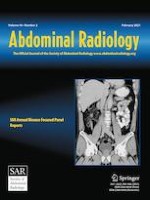Erschienen in:

03.08.2020 | Pancreas
Prognostic factors in patients with locally advanced or borderline resectable pancreatic ductal adenocarcinoma: chemotherapy vs. chemoradiotherapy
verfasst von:
Seung-seob Kim, Sunyoung Lee, Hee Seung Lee, Seungmin Bang, Mi-Suk Park
Erschienen in:
Abdominal Radiology
|
Ausgabe 2/2021
Einloggen, um Zugang zu erhalten
Abstract
Purpose
To identify common and unique pre-treatment prognostic factors in patients with borderline resectable (BR) or locally advanced (LA) pancreatic ductal adenocarcinoma (PDAC), treated with chemotherapy (CTx) or concurrent chemoradiotherapy (CRT).
Methods
We enrolled 215 patients with BR/LA PDAC, who were treated with either CTx (n = 82) or CRT (n = 133) as a first-line treatment between 2013 and 2016. Clinical data and CT imaging findings for predicting overall survival (OS) and progression-free survival (PFS) were analyzed using Cox regression analysis.
Results
Carbohydrate antigen (CA) 19-9 > 1000 U/mL (hazard ratio [HR] 1.91; p = 0.001) and non-homogeneous enhancement (HR 1.95; p < 0.001) were associated with shorter OS in all study populations. There was no significant difference in median OS (15.3 vs 16.8 months, p = 0.297) and PFS (10.0 vs 11.7 months, p = 0.321) between the CTx and CRT groups. Non-homogeneous enhancement (HR 2.04; p = 0.006) and presence of positive lymph node on CT (HR 2.38; p = 0.036) were associated with poor OS in the CTx group, while CA 19-9 > 1000 U/mL (HR 2.38; p = 0.001) and non-homogeneous enhancement (HR 1.73; p = 0.006) were independent predictors for poor OS in the CRT group.
Conclusion
Enhancement pattern on CT was a common prognostic factor for patients with PDAC treated with either CTx or CRT. Presence of positive lymph nodes on CT was a poor prognostic factor for the CTx group only, whereas CA 19-9 > 1000 U/mL was a poor prognostic factor for the CRT group only.











